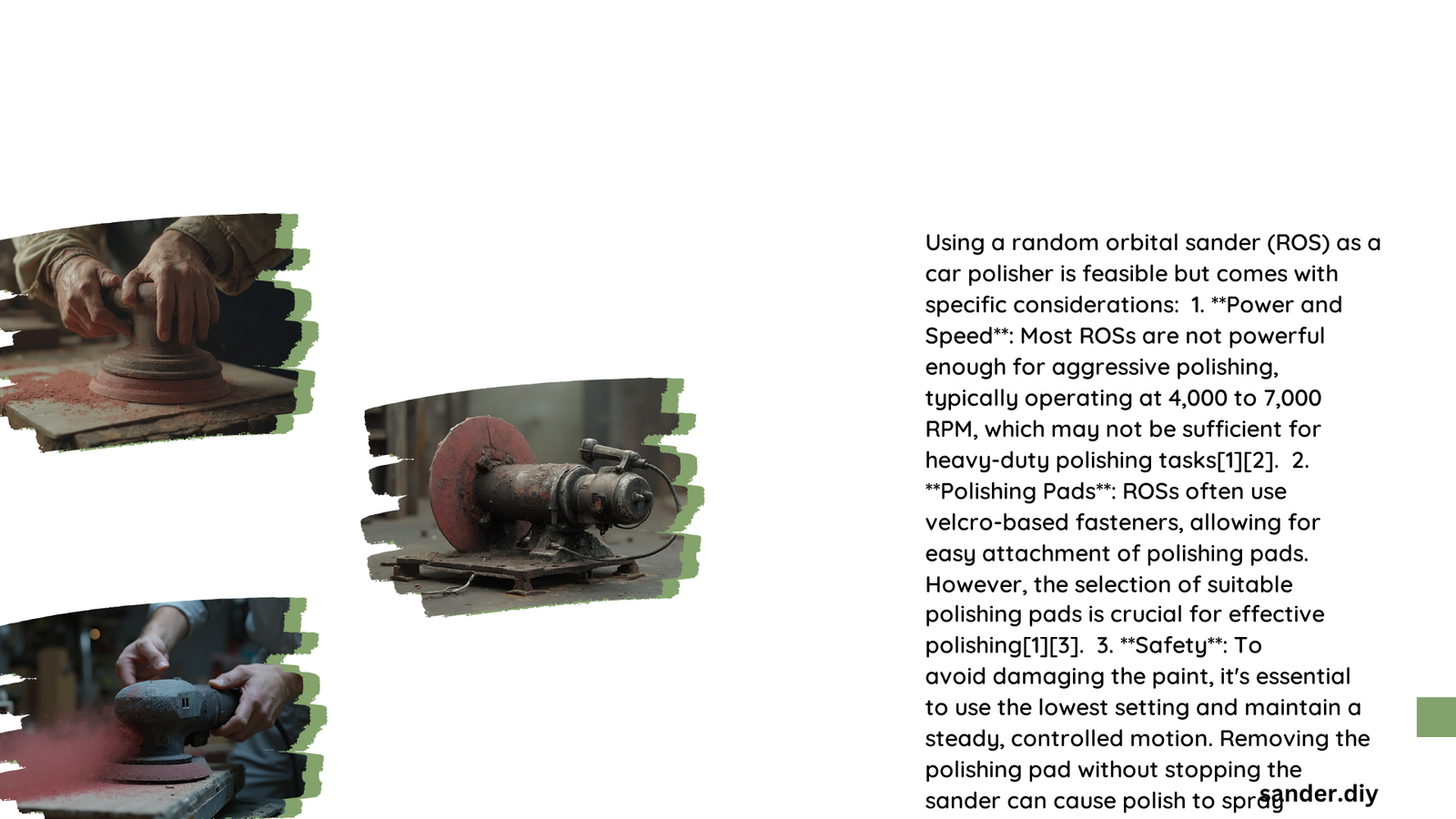A random orbital sander is a versatile tool that can be effectively used as a car polisher. It offers a balance of power and precision, making it ideal for automotive detailing. This guide explores the optimal settings, best models, effective pads, and advanced techniques for using a random orbital sander to achieve a professional-quality finish on your vehicle’s paintwork.
What Are the Optimal Speed Settings for Different Car Paint Finishes?
When using a random orbital sander as a car polisher, the speed settings play a crucial role in achieving the desired finish. Here’s a breakdown of recommended speeds for various tasks:
- Compounding and Polishing
- Speed: 5-6 on variable speed sander
- OPM (Orbits Per Minute): 4000-6400
-
Purpose: Removing imperfections and achieving a smooth finish
-
Fine Finishing
- Speed: 2-4 on variable speed sander
-
Purpose: Sanding between coats or polishing clear coats
-
Final Buffing
- Speed: 1-3 on variable speed sander
- Purpose: Achieving a high-gloss, swirl-free finish
Remember, these are general guidelines. Always start at a lower speed and gradually increase as needed, while monitoring the surface temperature to avoid damage.
Which Random Orbital Sander Models Are Best for Car Detailing?

Several random orbital sander models stand out for their performance in car detailing. Here’s a comparison of top models:
| Model | Motor Power | Orbit Size | Weight | Key Features |
|---|---|---|---|---|
| DeWalt D26441K | 3.0 AMP | 5-inch | 3.4 lbs | Variable speed, ergonomic design |
| Porter-Cable 7424XP | 4.5 AMP | 6-inch | 4.1 lbs | High-speed performance, versatile |
| 3M Random Orbital Sander | 3.0-4.0 AMP | 5-6 inch | 3-4 lbs | Durable, compatible with various pads |
Each of these models offers unique advantages for car detailing. The DeWalt D26441K is known for its versatility, the Porter-Cable 7424XP for its power, and the 3M models for their compatibility with a wide range of accessories.
How to Choose Effective Random Orbital Sander Pads for Automotive Use?
Selecting the right pads is crucial for achieving the desired finish. Here’s a guide to choosing effective pads:
- Grit Levels
- Coarse (400-800): For removing old paint, rust, or major imperfections
- Medium (1000-2000): For smoothing surfaces and preparing for finer polishing
-
Fine (3000-5000): For final polishing and achieving a high-gloss finish
-
Material Types
- Foam Pads: Ideal for polishing and finishing, available in various densities
-
Microfiber Pads: Excellent for fine polishing and achieving a flawless finish
-
Applications
- Cutting: Use coarse grit sandpaper for removing imperfections
- Polishing: Use medium to fine grit with foam or microfiber pads
- Finishing: Use fine grit with microfiber pads for a swirl-free, glossy finish
What Are Advanced Random Orbital Sander Car Polishing Techniques?
To achieve professional-level results, follow these advanced techniques:
- Preparation
- Clean the surface thoroughly
-
Use coarse grit (400-800) to remove major imperfections
-
Compounding
- Switch to medium grit (1000-2000)
- Use a compound to remove minor scratches
-
Set sander speed to 5-6
-
Polishing
- Use fine grit (3000-5000) with foam or microfiber pad
- Apply polish
-
Reduce speed to 3-4
-
Finishing
- Use microfiber pad with high-end polish or wax
- Apply gentle pressure
- Maintain slow, consistent speed (2-3)
Pro Tips:
– Always start with the least aggressive method and gradually increase if needed
– Keep the sander moving to avoid heat buildup
– Use proper lighting to spot imperfections
– Clean pads frequently to maintain effectiveness
How to Troubleshoot Common Issues When Using a Random Orbital Sander for Car Polishing?
Even experienced detailers can encounter challenges. Here’s how to address common issues:
- Swirl Marks
- Cause: Excessive pressure or incorrect speed settings
-
Solution: Use lighter pressure and appropriate speed for the task
-
Holograms
- Cause: Uneven application or incorrect pad/product combination
-
Solution: Ensure even coverage and use appropriate pads for each stage
-
Burning Through Clear Coat
- Cause: Excessive heat buildup or aggressive compounds
-
Solution: Use lower speeds, take frequent breaks, and start with less aggressive products
-
Uneven Finish
- Cause: Inconsistent pressure or speed
- Solution: Maintain steady pressure and speed, use a cross-hatch pattern
By understanding these techniques and troubleshooting methods, you can effectively use a random orbital sander as a car polisher to achieve professional-quality results.
References:
1. Uneeda: Electric Sander Speeds 101
2. FastPlus.eu: How to Properly Use an Orbital Sander for Car Repair
3. Autogeekonline.net: Recommended Speed Settings on Random Orbital Polisher
